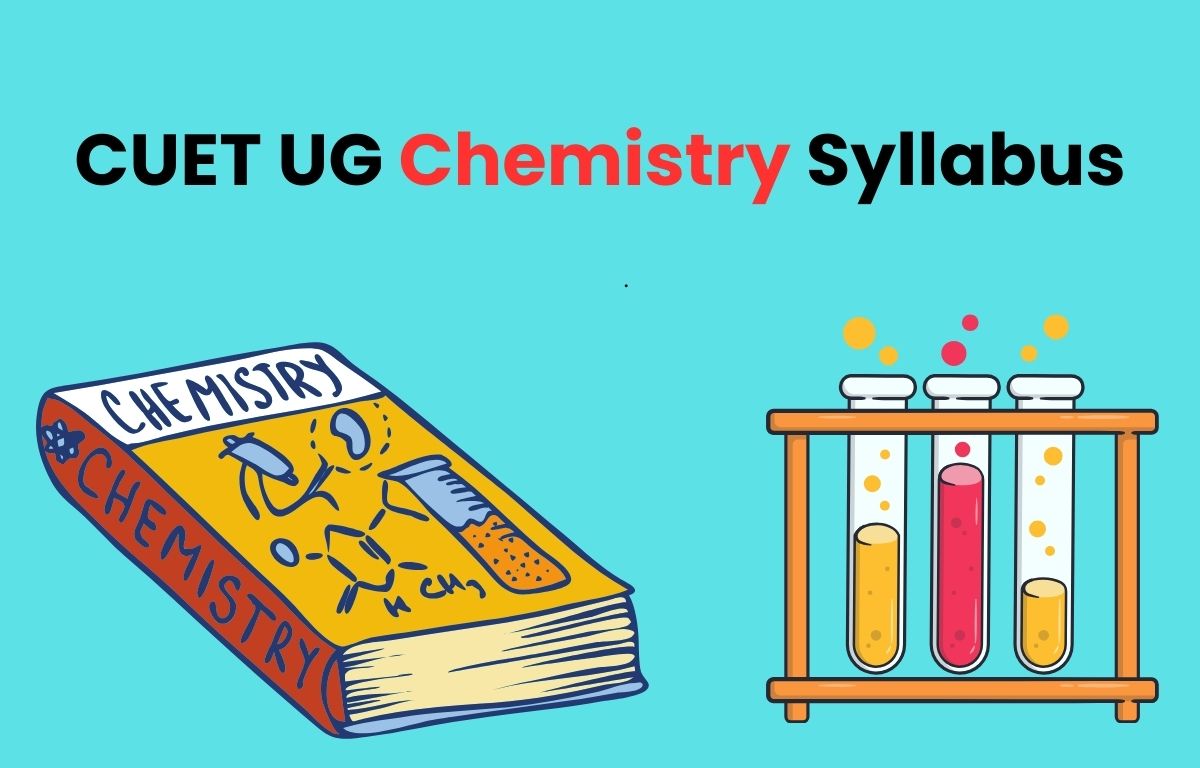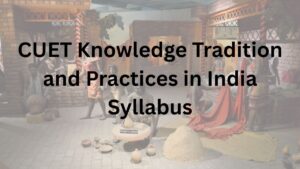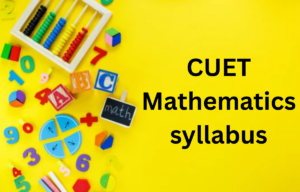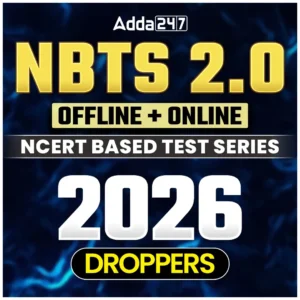The CUET Chemistry Syllabus 2026 will soon be updated at the official website of the National Testing Agency, i.e., the conducting authority for the Common University Entrance Test. All the aspirants with their objective to get admission into bachelor-level courses having chemistry as one of their domain subjects must now start preparing for the exam by understanding all the concepts and topics mentioned on the CUET Syllabus 2026 for Chemistry.
As a process to help students complete their CUET Preparations on time, we have added the topic-wise CUET Chemistry Syllabus 2026 in the article below. Scroll down in the article and check the subject-wise syllabus.
CUET Chemistry Syllabus 2026
The CUET 2026 exam, or Common University Entrance Test for Undergraduates, is a test used by many universities in India to select students for their undergraduate courses. It helps colleges find students who are good at different subjects. The CUET exam has three sections. Sections 1A and 1B focus on languages, Section II covers 27 specific subjects, and Section III is a general test.
The test evaluates your understanding in subjects such as English, Mathematics, and General Studies. Chemistry is included in Section II, featuring 45 to 50 questions, where students are required to attempt any 35 to 40 of them. The total marks for the Chemistry section of the CUET exam are 200. Scoring well in the CUET UG exam can increase your chances of gaining admission to various colleges and universities.
CUET UG Syllabus 2026 for Chemistry
The CUET Chemistry syllabus has three parts – Physical, Inorganic, and Organic Chemistry. In Physical Chemistry, you learn how energy changes during reactions. Inorganic Chemistry teaches about elements and their compounds. Organic Chemistry is all about carbon compounds and how they behave. These topics cover the basic ideas you need to understand Chemistry well. The syllabus helps students learn about the structure, properties, and changes in substances. It builds a strong base for the exam. For the latest details, you can check the CUET UG Chemistry Syllabus 2026 overview table shared below. It gives a clear idea of the topics.
| CUET Chemistry Syllabus 2026 | |
| Division | Important Topics |
| Physical Chemistry | Chemical Kinetics, Surface Chemistry, Solutions, and Electrochemistry |
| Organic Chemistry | Haloalkanes and Haloarenes, Biomolecules, Aldehydes, Ketones, Carboxylic Acids, Alcohols, Phenols, Ethers, Polymers, and Chemistry in Everyday Life |
| Inorganic Chemistry | P-Block Elements, Coordination Compounds, General Principles and Processes of Isolation of Elements, and d-and f-Block Elements |
CUET Chemistry Syllabus – Topics
The CUET Chemistry syllabus includes chemical reactions, basic calculations, and their everyday applications. Students should focus on understanding key topics and practicing problems to prepare well. The syllabus is designed to make learning easier and helps students connect concepts with real-life uses. By studying the main ideas and solving related questions, students can improve their understanding and perform better in the exam.
- Atomic Structure
- Chemical Bonding
- Redox Reactions
- Chemical Equilibrium and Kinetics
- Acid-Base Concepts
- Electrochemistry
- Catalysis
- Colloids
- Colligative Properties of Solution
- Periodic Table
- Preparation and Properties
- Thermochemistry
- General Organic Chemistry
- Reaction intermediates
- Isomerism
- Polymers
- Carbohydrates
- Preparation and Properties
- Solid State
- Petroleum
CUET UG Chemistry Syllabus – Unit Wise
The CUET UG Chemistry Syllabus 2026 covers Physical, Inorganic, and Organic Chemistry, with topics aligned with the NCERT Class 11 and 12 curriculum. All the candidates who are to appear for the CUET UG Exam 2026 must now start reading topics like Solid State, Solutions, Electrochemistry, Chemical Kinetics, p-Block, d & f Block elements, Coordination Compounds, Haloalkanes, Alcohols, Biomolecules, Polymers, and Chemistry in Everyday Life.
Below, we have mentioned the Unit Wise CUET UG Chemistry Syllabus 2026 so that all the aspirants can start preparing for the exam using it.
Unit I: Solid State
Classification of solids based on different binding forces: molecular, ionic covalent, and metallic solids, amorphous and crystalline solids(elementary idea), unit cell in two-dimensional and three-dimensional lattices, calculation of density of unit cell, packing in solids, packing efficiency, voids, number of atoms per unit cell in a cubic unit cell, point defects, electrical and magnetic properties, Band theory of metals, conductors, semiconductors and insulators and n and p-type semiconductors.
Unit II: Solutions
Types of solutions, expression of concentration of solutions of solids in liquids, the solubility of gases in liquids, solid solutions, colligative properties – the relative lowering of vapour pressure, Raoult’s law, the elevation of B.P., depression of freezing point, osmotic pressure, determination of molecular masses using colligative properties, abnormal molecular mass, Vant Hoff factor.
Unit III: Electrochemistry
Redox Reaction; conductance in electrolytic solutions, specific and molar conductivity variations of conductivity with concentration, Kohlrausch’s Law, electrolysis and laws of electrolysis (elementary idea), dry cell – electrolytic cells and Galvanic cells; lead accumulator, EMF of a cell, standard electrode potential, Nernst equation and its application to chemical cells. Relation between Gibbs energy change and EMF of a cell, fuel cells; corrosion.
Unit IV: Chemical Kinetics
Rate of a reaction (average and instantaneous), factors affecting rates of reaction: concentration, temperature, catalyst; order and molecularity of a reaction; rate law and specific rate constant, integrated rate equations, and half-life (only for zero and first-order reactions); concept of collision theory (elementary idea, no mathematical treatment). Activation energy, Arrhenius equation.
Unit V: Surface Chemistry
Adsorption – physisorption and chemisorption; factors affecting adsorption of gases on solids; catalysis: homogenous and heterogeneous, activity and selectivity: enzyme catalysis; colloidal state: the distinction between true solutions, colloids, and suspensions; lyophilic, lyophobic multimolecular and macromolecular colloids; properties of colloids; Tyndall effect, Brownian movement, electrophoresis, coagulation; emulsions – types of emulsions.
Unit VI: General Principles and Processes of Isolation of Elements
Principles and methods of extraction – concentration, oxidation, reduction, electrolytic method, and refining; occurrence and principles of extraction of aluminium, copper, zinc, and iron.
Unit VII: p-Block Elements
- Group 15 elements: General introduction, electronic configuration, occurrence, oxidation states, trends in physical and chemical properties; nitrogen – preparation, properties, and uses; compounds of nitrogen: preparation and properties of ammonia and nitric acid, oxides of nitrogen (structure only); Phosphorous-allotropic forms; compounds of phosphorous: preparation and properties of phosphine, halides (PCl3, PCl5) and oxoacids (elementary idea only).
- Group 16 elements: General introduction, electronic configuration, oxidation states, occurrence, trends in physical and chemical properties; dioxygen: preparation, properties, and uses; classification of oxides; ozone. Sulphur – allotropic forms; compounds of sulphur: preparation, properties, and uses of sulphur dioxide; sulphuric acid: industrial process of manufacture, properties and uses, oxoacids of sulphur (structures only).
- Group 17 elements: General introduction, electronic configuration, oxidation states, occurrence, trends in physical and chemical properties; compounds of halogens: preparation, properties and uses of chlorine and hydrochloric acid, interhalogen compounds, oxoacids of halogens(structures only).
- Group 18 elements: General introduction, electronic configuration, occurrence, trends in physical and chemical properties, and uses.
Unit VIII: d and f Block Elements
- General introduction, electronic configuration, occurrence and characteristics of transition metals, general trends in properties of the first-row transition metals – metallic character, ionization enthalpy, oxidation states, ionic radii, colour, catalytic property, magnetic properties, interstitial compounds, alloy formation. Preparation and properties of K2Cr2O7 and KMnO4.
- Lanthanoids – electronic configuration, oxidation states, chemical reactivity, and lanthanoid contraction and its consequences.
- Actinoids –Electronic configuration, oxidation states, and comparison with lanthanoids.
Unit IX: Coordination Compounds
Coordination compounds: Introduction, ligands, coordination number, colour, magnetic properties and shapes, IUPAC nomenclature of mononuclear coordination compounds, bonding, Werner’s theory VBT, CFT; isomerism (structural and stereo)importance of coordination compounds (in qualitative analysis, extraction of metals and biological systems).
Unit X: Haloalkanes and Haloarenes
- Haloalkanes: Nomenclature, nature of C-X bond, physical and chemical properties, mechanism of substitution reactions. Optical rotation.
- Haloarenes: Nature of C-X bond, substitution reactions (directive influence of halogen for monosubstituted compounds only).
- Uses and environmental effects of–dichloromethane, trichloromethane, tetrachloromethane, iodoform, freons, DDT.
Unit XI: Alcohols, Phenols, and Ethers
- Alcohols: Nomenclature, methods of preparation, physical and chemical properties (of primary alcohols only); identification of primary, secondary, and tertiary alcohols; mechanism of dehydration, uses, with special reference to methanol and ethanol.
- Phenols: Nomenclature, methods of preparation, physical and chemical properties, acidic nature of phenol, electrophilic substitution reactions, uses of phenols.
- Ethers: Nomenclature, methods of preparation, physical and chemical properties, uses.
Unit XII: Aldehydes, Ketones, and Carboxylic Acid
- Amines: Nomenclature, classification, structure, methods of preparation, physical and chemical properties, uses, identification of primary, secondary, and tertiary amines.
- Cyanides and Isocyanides – will be mentioned at relevant places in context.
- Diazonium salts: Preparation, chemical reactions, and importance in synthetic organic chemistry
Unit XIV: Biomolecules
Carbohydrates – Classification (aldoses and ketoses), monosaccharide (glucose and fructose), D-L configuration, oligosaccharides (sucrose, lactose, maltose), polysaccharides (starch, cellulose, glycogen): importance.
Proteins – Elementary idea of a-amino acids, peptide bond, polypeptides, proteins, primary structure, secondary structure, tertiary structure, and quaternary structure (qualitative idea only), denaturation of proteins; enzymes.
Hormones –Elementary idea (excluding structure).
Vitamins – Classification and functions.
Nucleic Acids: DNA and RNA
Unit XV: Polymers
Classification – Natural and synthetic, methods of polymerization (addition and condensation), copolymerization. Some important polymers: natural and synthetic like polythene, nylon, polyesters, bakelite, and rubber. Biodegradable and non-biodegradable polymers.
Unit XVI: Chemistry in Everyday Life
- Chemicals in medicines – analgesics, tranquilizers, antiseptics, disinfectants, antimicrobials, antifertility drugs, antibiotics, antacids, antihistamines.
- Chemicals in food– preservatives, artificial sweetening agents, elementary idea of antioxidants.
- Cleansing agents – soaps and detergents, cleansing action.
CUET Chemistry 2026: Important Books
For CUET UG Chemistry preparation, choosing the right books is key. Good books easily explain tough concepts and provide many practice questions. They help students to understand the subject better and improve their performance in exams. The right books will strengthen the student’s basics and boost their confidence. With proper study materials, you can prepare well and score high. Here are some useful books that will make learning Chemistry simple and effective for your CUET Chemistry exam success.
- NCERT Chemistry Textbooks (Class 11 and 12) – Essential for understanding basic concepts.
- Physical Chemistry by O.P. Tandon – Good for practice and deeper understanding.
- Organic Chemistry by Morrison and Boyd – Excellent for organic chemistry topics.
- Inorganic Chemistry by J.D. Lee – Helps with understanding inorganic chemistry in detail.
- Chemistry: A Modern Approach by R. C. Mukherjee – Useful for problem-solving and revision.
Preparation Tips For CUET UG Chemistry Exam
Preparing for the Common University Entrance Test (CUET) for undergraduate (UG) programs in Chemistry requires a well-structured approach. By following these tips and staying consistent with your study plan, you’ll be well-prepared to tackle the CUET UG Chemistry exam. Here are some tips to help you prepare effectively:
1. Understand the Syllabus
- Familiarize yourself with the CUET syllabus: It will be based on your Class 12 syllabus. Focus on topics like Physical Chemistry, Organic Chemistry, and Inorganic Chemistry.
- Identify important topics: Prioritize topics that carry more weight in the exam.
2. Create a Study Plan
- Divide your time wisely: Allocate more time to difficult topics while ensuring you regularly review easier ones.
- Set daily/weekly goals: This helps in keeping track of your progress and staying motivated.
3. Focus on Conceptual Clarity
- Strengthen your basics: Make sure you understand the fundamental concepts as they are often tested in various ways.
- Use reference books: Books like NCERT are crucial, but you can also refer to other books like “Physical Chemistry” by P. Bahadur or “Organic Chemistry” by O.P. Tandon for a deeper understanding.
4. Practice Regularly
- Solve previous years’ papers: This helps you get familiar with the exam pattern and types of questions asked.
- Take mock tests: Regular mock tests will help you manage your time effectively and reduce exam-day stress.
- Analyze your performance: Review your mistakes in mock tests and previous papers to avoid repeating them.
5. Time Management
- Practice solving questions under timed conditions: This will help you improve your speed and accuracy.
- Learn to prioritize questions: Attempt the easier questions first to secure marks, then move on to the more difficult ones.



 CUET Knowledge Tradition and Practices i...
CUET Knowledge Tradition and Practices i...
 CUET General Test Syllabus 2026 Out, Dow...
CUET General Test Syllabus 2026 Out, Dow...
 CUET Maths Syllabus 2026, Check Section ...
CUET Maths Syllabus 2026, Check Section ...










